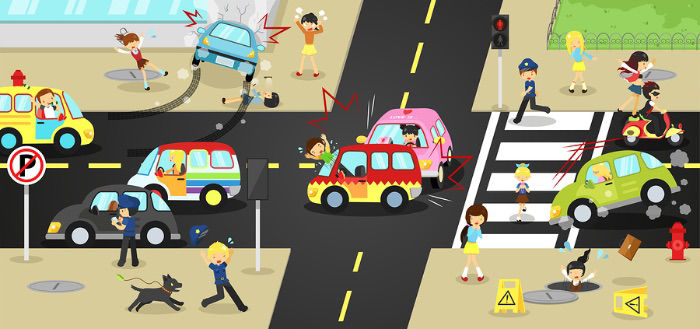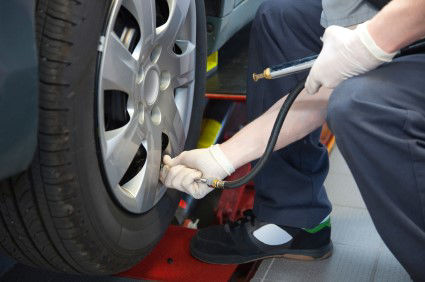NHSA Blog
Understanding who has the right of way

Safe drivers understand that driver safety involves being aware of their surroundings at all times. Understanding the “rules of the road”, including a keen awareness of who has the right of way in all situations will improve safety and reduce the risk of an incident. Take note of who has the right of way in the following scenarios.
1 At stop signs
If you are at a stop sign you should come to a complete stop and then allow other cars, pedestrians, and cyclists to go. The first driver to stop at a 4-way stop should be the first to proceed. If you happen to arrive at the same time as another car then the car on the right should go first.
2 Intersections with no traffic signs or signals
When entering this type of intersection, you should yield to vehicles that are already in the intersection. Before turning left, you should yield to any vehicle that is coming from the opposite direction.
3 Driveways, alleys, and roadsides
If you are entering or exiting any of these you need to yield the right-of-way to any vehicle, cyclist, or pedestrian that is using the road or sidewalk.
4 Yielding to emergency vehicles
The law requires drivers to yield to any authorized emergency vehicle. If the driver is unable to move over or is on a single-lane road they must slow down to allow the emergency vehicle to pass.
5 Yielding to pedestrians
You must always allow pedestrians to have the right of way. Be particularly alert for those who may be blind. It is often possible to identify blind pedestrians by their use of a guide dog or a white cane.
While these examples are not all-inclusive, they can help you to understand what right-of-way involves and how yielding to others on the road can save lives. Stay alert! To lessen the risk of a collision, you should never assume that other drivers would show courtesy or follow the above guidelines.
At NHSA, our goal is to provide the highest quality online driver education training for teens and adults. Log on and see what courses are available in your state!
Reasons why you are more likely to get into an accident close to home

Data collected by the NHTSA, (National Highway Transportation Safety Board) continues to show that most accidents take place within a few miles of driver’s homes. Understanding the reasons why can assist drivers to take proactive steps to reduce these risks and get home safely.
One logical reason that accidents take place close to home is that most of our driving is done near our home. The grocery store, school drop-offs, doctor’s appointments, etc. are routinely selected in part by their proximity to our residence.
Since we are most familiar with areas near our home it is possible to let our guard down. The safe driving practice would be to not allow our guard to drop due to overconfidence. Remaining vigilant at all times while driving is essential in reducing driving risks.
Another common factor in vehicular accidents is driver fatigue. A study done by the CDC (Center for Disease Control and Prevention) stated that 37% of adults get less sleep than they should. A fact that speaks volumes of the potential for driving while tired. A tired driver can have increased risks similar to one who has been drinking. If we are exhausted on our way home from work or perhaps from a long drive, we can easily miss identifying certain risks in time. Getting sufficient rest along with a healthful diet or even allowing a more rested passenger to drive will help to get home safely.
At NHSA, we are committed to helping all drivers to be safe drivers. Our online driver’s education classes and basic driver safety courses will help you to be fully prepared for driving safely. See what driving classes are available in your state!
The importance of tire safety

According to a report from the NHTSA, over 600 motor vehicle deaths in 2019 can be directly blamed on the tires of vehicles involved. It is also noteworthy that driving your vehicle with badly worn tires puts you at three times the risk of having an accident as opposed to vehicles with tires that have sufficient tread depth. Understanding important facts about your tires will help to keep you safe while driving.
Tread depth
Having sufficient tread depth is essential for safe driving, particularly in the rain or snow. The tire tread will wear down over time so it is important to understand at what point they must be replaced. Tread that wears down to 2/32 of an inch depth is considered unsafe to drive with. The easiest way to measure this is by doing the “penny test.” Place a penny with Lincoln’s head pointing into the tire. If you can see the top of Lincoln’s head, then you are at 2/32 of an inch and the tires need to be replaced.
Tire condition
Tires are designed to last about 5 years and up to 50,000 miles or more. This doesn’t mean that they can’t wear out sooner. Regularly inspecting your tires will help you to immediately recognize signs of unusual wear or even damage. This is even more important if you live in an area where you consistently drive in hotter temperatures. Driving on roads for an extended time in hot temperatures can break down the materials of the tire. California drivers and Texas drivers are more likely to face such conditions. State legislatures have even passed stricter tire requirements in these states to reduce unnecessary risks.
Tire Maintenance
Minor issues left unchecked can reduce the life of your tires. It is a safe driving practice to check your tire pressure once a month to prevent over or underinflation, both of which can cause faster tire wear. Make sure your tires are properly balanced and aligned. Rotating your tires every 5000 to 8000 miles is a standard recommendation from tire manufacturers.
At NHSA, we are committed to providing all drivers with what they need to be safe and well informed. We offer online driver's education courses for teen drivers getting their permit, or basic driver safety courses for those looking to save on auto insurance and feel more prepared to be a safe, defensive driver.
4 Important tips to drive safely in the rain

The weather can easily change our plans. Sometimes we have no choice but to continue with certain obligations even though driving in the rain brings greater risks. The following tips will help new drivers and experienced drivers to employ safe driving practices while driving in the rain.
1 Have good visibility
Rain can limit our visibility. Be proactive to maximize visibility by doing the following:
- Keep your windshield clean
- Make sure wipers are in good condition
- Make sure the defogger works
- Keep headlights properly focused
- Don’t use your high-beams
2 Don’t drive too fast
It can take longer to stop when the road is wet. Even light rain can bring oils up to the surface creating a greater risk of skidding. Driving at a safe speed will give you greater reaction time and stopping time.
3 Keep a safe distance from other vehicles
It is generally accepted that 3 or 4 seconds is a safe following distance in ideal driving conditions. It is safest to double that distance in the rain. In addition, make sure you try to keep from driving directly next to another vehicle on roads with multiple lanes. If one of you drives into a large puddle it can pull one car towards the other and lead to an accident.
4 Avoid hard braking
Tips 2 and 3 can help to reduce the likelihood of the need to brake hard. However, there is always the possibility of an abrupt event occurring where you will need to stop quickly. Applying the brakes gently and then gradually more firmly will help avoid skidding or hydroplaning.
At NHSA, we want to help all drivers to be safe drivers. Check out our online driver’s ed classes and basic driver safety courses to see how we can help you as well!
How to talk to your teen about safe driving

Teenage drivers between the ages of 16 and 19 are at the highest risk for automobile accidents. For that reason, parents do well to address these risks before their child gets behind the wheel to best prepare them to be safe drivers. The following reminders will assist in having a productive discussion with them.
Your example speaks louder than your words.
Teen drivers are at a higher risk for a variety of reasons. They are more likely to engage in risky driving behaviors such as speeding, texting, or talking on their device while driving or not wearing a seatbelt. Parents who avoid such risky driving behaviors themselves have already set a good pattern that their teens have observed for years.
Keep the atmosphere calm and relaxed
Parents can easily run into challenges while communicating with their teenage children if children feel they are being scolded. Rather than simply stating a list of do’s and don’ts, involve them in the conversation. Many times asking a question rather than making a statement can help to discern how they feel about something. Note some possible questions that can address real concerns and allow your teen to express themself.
Why do you think teen drivers are at greater risk than all other ages?
How can you avoid risky driving behavior?
How can you help your friends drive safely?
Set boundaries and communicate consequences
Established rules and boundaries that encourage safe driving can save lives. Communicating the consequences that they may face if they break some of your established boundaries will help to avoid the risk taken from becoming a pattern of risky driving.
Our goal at NHSA is to assist all drivers to be safe drivers. Please take note of our parent-taught driver education courses or our practice test for the learner’s permit available in your state!
6 Ways your car may be trying to warn you

Vehicles are more prepared than ever to detect issues before they become bigger problems. Understanding the signs and warnings your car is giving you will save both time and money and help you be a safe driver and avoid unnecessary distractions.
1 Warning lights
Most of the time warning lights are reminders for very minor maintenance items. Sensors for tire pressure or oil usually take very little effort to correct. Other warning lights such as “Check Engine” may require you to visit your mechanic for diagnosis.
2 Temperature Gauges
A vehicle requires a variety of fluids to work properly. Normally, these fluids will heat up while driving, and the temperature gauges will show a normal range for the temperature of the fluids to stay within. If you notice the gauges moving into the red it is time to get this diagnosed before it causes an expensive problem.
3 Fluid levels
Fluids such as engine coolant and power steering fluid can last for years. Oil can last thousands of miles. Changes in these fluid levels earlier than expected may indicate your engine is developing a problem. An occasional top off of such fluids is one thing, but if you regularly notice any of these fluid levels dropping below normal levels, schedule time for your mechanic to take a look.
4 Unusual Sounds
Engines have parts that may be moving at thousands of RPMs (revolutions per minute). Parts can easily wear over time due to friction. Friction will often make noise that may help you determine what and where the problem may be. Is the noise under the hood or does it seem to come from the wheels? Is it high-pitched like a squeak? Or is it lower like humming? These details can help a professional to properly address the issue.
5 Vibrations
Vibrations, such as the shaking of your steering wheel may reveal a wheel alignment issue or that the tires are out of balance. This type of shaking is normally felt between a particular range of highway speeds. Shaking of the car felt at very low speeds such as when coming to a stop may reveal weaknesses in one or more tires. Tire safety is essential to safe driving practices.
6 Fumes
The last thing you need while driving is to smell burning fumes. A sudden aroma of fumes may indicate a problem with hoses or connections within the engine. More visible signs of fumes such as smoke or very strong odors should be addressed immediately.
Our goal at NHSA is to help all drivers to be safe drivers. Check out our online driver’s ed courses that include parent-taught classes for teens seeking their learner’s permit as well as defensive driving and basic driver safety courses aimed at saving you money. We are here to help!
3 Easy steps to avoid distractions while driving

According to statistics kept by the NHTSA, approximately 3,000 people die each year as a result of distractions while driving. Limiting distractions while driving is a key component of being a safe driver. The listed items below will help take proactive steps to reduce the risks.
1. Don’t use your phone while driving!
Our devices have become an extension of our bodies. Many people cannot go for very long without using their devices. Using a safe driving setting on your phone will prevent alerts from getting your attention and avoid the impulse to pick up the phone.
2. Limit activity within the vehicle.
Passengers and pets can be very distracting to a driver. Keeping noise and activity within the vehicle to a reasonable level will prevent your attention from being taken off of your driving.
3. Stay disciplined.
There are countless factors outside the vehicle that can pull our eyes away from the road. Billboards, wildlife, scenery, pedestrians, and other drivers can easily divert our focus if we allow them to. Keeping disciplined and only looking momentarily before focusing back on the road will prevent something we see from becoming something we are staring at.
At NHSA, we want to help all drivers to be safe drivers. Check out our online driver’s ed classes and basic driver safety courses to see how we can help you as well

Tips for driving safely at night
Car accident fatalities are three times more likely to take place at night, according to research done by the National Highway Transportation Safety Administration, or (NHTSA). Taking a few steps will help to reduce your risks while driving at night.
1. Keep your vision clear.
Visual perception has a significant effect on reaction times. You can ensure better reaction time while driving at night by doing the following:
- * Keep your windshield clean
- * Keep headlights properly aimed
- * Get your eyes examined each year
- * Avoid looking directly at the headlights of other drivers
2. Slow down.
You cannot see as far ahead at night as you can during the day. Give yourself more time to react by driving a few miles an hour slower. Setting the cruise control can help to avoid accelerating without realizing it.
3. Avoid impairments to your driving.
Driving while drowsy and driving after drinking alcohol are two of the most common factors in driving fatalities. Be modest, if you are feeling the effects of fatigue, either pull over to a safe place to have a brief rest or allow another passenger to drive. In addition, having a designated driver who has not consumed any alcohol is always the safest practice.
At NHSA, we want to help all drivers to be safe drivers. Check out our online driver’s ed classes and basic driver safety courses. From teen drivers seeking a learner's permit, to mature drivers seeking to save on car insurance, see how we can help you as well!

Safe driving tips when renting a vehicle
If you are renting a vehicle, you are likely on vacation or at least need a vehicle other than yours for some purpose. The following tips will help make sure you are prepared in advance for factors that could put you at greater risk of an incident.
Get familiar with the rental vehicle’s features.
Likely, the rental vehicle will not be the make and model of your vehicle. This means that the location of controls for basic functions may not be in the exact location you are used to. Controls for temperature, defogging, headlights, and hazard lights can be needed abruptly. Taking your eyes off the wheel for a moment to find such controls while driving can lead to serious risks. This is especially true if you rent a moving truck or tow a vehicle.
Set anything that needs to be adjusted to you before driving.
Adjust the side mirrors and the rearview mirror as needed. Next, take a moment to look around to look for potential blind spots.
Know where you are going.
We all know what it feels like to get lost while driving. It also takes extra focus to be looking for landmarks or street signs along your way. If you are planning a trip to an unfamiliar location, make sure you have looked at the route in advance to have a general idea of what you need to do. Many who rely on a navigation system are still prone to making a mistake because they are unfamiliar with the route taken.
At NHSA, we want to help all drivers to be safe drivers. Our online driver's ed courses are designed for the needs of any driver. Teen drivers can get ready to qualify for their learner's permit or enroll in a parent taught driving course. Experienced drivers can take basic driver safety classes to remove points from their driver's license or to reduce auto insurance rates. We are here to help!
Best drivers ed resources for Florida residents

Each new year brings more new drivers to the state of Florida. Some are teen drivers looking to dive into their new found independence. Others are new Florida residents who either move from out of state or even from other countries. Having the proper tools to help prepare you to be a successful defensive driver is incredibly valuable. Below are highly rated online drivers ed resources that assist new drivers gain confidence and competence. Additional driving courses included in this article will help to qualify for auto insurance discounts or to help remove points or fines drivers may receive from moving violations or infractions.
Teen driver safety. We likely remember the excitement of getting behind the wheel for the first time. We likely took a picture when we bought our first car. But do we remember the butterflies in our stomach when taking the driver’s ed test for the permit? Or the anxiety of taking the road test? Nobody wants to fail or have to take such driving tests twice! In addition, young drivers are associated with greater driving risks. This FREE online practice test will help drivers become more confident and familiar with the knowledge one must obtain to be a safe driver. First-time drivers can take the practice test over and over at no cost!
Reduce points or insurance rate increases. Life today is complex and full of distractions. Many have limited time and always seem to be in a rush. If we are not careful, we can develop unsafe driving habits that may put others or ourselves at risk. If we are cited for a moving violation, we can incur points on our driving record which can lead to auto insurance rate increases. This FREE online driver education course can help to remove the points from your license associated with the infraction, and help prevent your insurance rates from increasing. In addition, if you have been cited for using your phone while driving, this Wireless Communications Device Safety course can also dismiss points from your driver’s license.
Senior citizen driver safety. As we age, we can deal with circumstances that affect driver safety. This report done recently by the CDC (Centers for Disease Control and Prevention) is a sobering reminder that refresher training and ongoing driver education is vital for safe driving. Mature drivers over the age of 55 will benefit from this mature driving safety course. It is educational and can help to reduce the cost of your auto insurance premiums!
See what online driver safety courses are available in your state.
Was this article helpful? Please comment or share.

